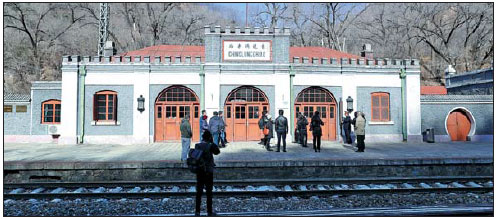Qinglongqiao stationmaster follows in father's footsteps at 100-year-old building
Qinglongqiao stationmaster Yang Cunxin has worked at the century-old station on the Beijing-Zhangjiakou railway for 36 years.
Yang said he will retire in 2022 and looks forward to taking the new train to Zhangjiakou to watch the 2022 Winter Olympic Games.
When he was a boy, his father worked as the stationmaster at Qinglongqiao station.
He eventually followed in his father's footsteps, devoting his life to the station through both its bustling and silent seasons.
A hundred years ago, engineer Zhan Tianyou (1861-1919) designed the old Beijing-Zhangjiakou railway. It was the first railway designed, funded and built entirely by Chinese people.
To cope with the mountainous terrain, Zhan built a new railway system stretching into the mountains.
The Qinglongqiao station is a reversing station for railways, using a zigzag alignment at which trains have to reverse direction to continue.
But after serving for a century, the once busy railway route has become less favored.
The senior stationmaster said: "In the 1990s, we sold more than 1,000 tickets per hour on weekends, while now, the century-old station is just for parking, technically. Only two colleagues and I work in the station every day."
Some tourists still come to the station to see its original look from a century ago. It illustrates the historic evolution of the Beijng-Zhangjiakou Railway Station and extols the outstanding talent and noble spirit of Zhan Tianyou.
A new Beijing-Zhangjiakou high-speed railway is under construction now. When completed, it will be China's first ballast high-speed track with a designed speed of 350 kilometers per hour.
The high-speed railway will improve traffic conditions and contribute to the coordinated development of the Beijing-Tianjin-Hebei region. It is also expected to play an important role in transportation during the 2022 Winter Olympic Games.
"It will take only 50 minutes to go from Beijing to Zhangjiakou by high-speed railway. It's more convenient for visitors and residents all around," Yang said.
The new high-speed railway will also help to combine the environmental and tourism resources of Beijing and Zhangjiakou.
The two cities will be able to integrate their tourism resources, such as the grassland scenery, ski resorts and vineyards of Zhangjiakou with Beijing's Palace Museum, Summer Palace and the Great Wall.
Once the new railway is put into operation, Zhangjiakou will be included in Beijing's "one-hour traffic circle" and become the backyard garden for Beijing residents through sightseeing, tours, health and holidays.
Cao Yingying contributed to this story.
|
The Qinglongqiao station on the Beijing-Zhangjiakou railway, built 100 years ago, has become a local tourist attraction.Zhu Xingxin / China Daily |
(China Daily 03/07/2017 page8)















